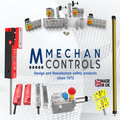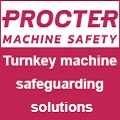
Posted to News on 31st Jul 2007, 19:34
Arguments in favour of investing in industrial robots
Stirling Paatz, MD of Barr & Paatz, believes that today people should not be asking themselves 'why robots?' but 'why not robots?'.
With the growing emphasis on speed of production and maintaining competitiveness in an increasingly global marketplace, the need for efficient and flexible robotics technology has become a key consideration for many businesses in manufacturing industry. That explains why the annual market for industrial robots surged by 30 per cent in 2005, according to figures from the International Federation of Robotics, while a recent ARC Advisory Group study predicts the global robotics market hitting over $5billion by 2010.
Nor is this market growth coming from traditional robot users, the automotive and electronics industries; rather it is coming from small and medium-sized businesses in industries like food and packaging, plastics and rubber, pharmaceuticals, household appliances, even wood and furniture. In these sectors, requirements for more flexible manufacturing processes and shorter product lead times, allied to rising labour costs and stricter health and safety legislation, have triggered investment in the speed, precision, repeatability and versatility of industrial robots.
Robot technology has itself undergone rapid change over the past decade or so, with cutting-edge manufacturers focusing on continuous improvements in machine productivity and performance, to the point where a robot today would cost less than a quarter of one bought in 1990, with equivalent functionality. Thanks to this superior technology, installation footprints are smaller, working envelopes are greater, operating noise levels are lower, programming and interfacing with other systems are easier, and meantime-between-failure rates are 200 per cent improved. All of which is good news for manufacturers looking for a faster return on investment, payback now being in the region of two to four years, or even less when factoring in double shifts or 24/7 operation.
Areas of application
In modern manufacturing there are many tasks that require constant attention to detail and the customer can recoup substantial financial dividends by exploiting the precision, repeatability and sheer reliability of industrial robots, for undertaking such duties. At +/-0.02mm repeatability, a robot can perform meticulous functions that a human could not expect to achieve, time after time, with no breaks or lapsed concentration. In hazardous areas or where heavy lifting is involved, robots can safely replace manpower; while in cleanrooms and hygiene-critical applications, machines can eliminate contamination and satisfy health and safety criteria. Similarly routine and often tedious tasks like machine minding, mould unloading, product orientation and palletising can be readily automated, freeing up staff for more demanding, cognitive roles.
Once properly applied, aligned and programmed, a robot can perform routine functions to very fine tolerances, eradicating problems associated with human error, and consistently producing high-quality output. This translates into increased net output, thanks to reduced scrap and rejects, while a robot's capacity to work faster, often operating round-the-clock, maximises gross throughput too. What is more, a properly maintained robot can give an average fifteen years service life, according to an IFR pilot study, with perhaps five years between minor breakdowns, which is an impressive performance when taking into account the speed, complexity and consistency of operation.
The trend toward shorter product life cycles and greater manufacturing flexibility also suggests that, within that extended ownership period, a robot is likely to be reprogrammed and redeployed any number of times to perform totally different functions. Unlike such fixed automation as CNC and gantry machines, multi-axis industrial robots have the inherent flexibility to accommodate new processes and functions, without engineers having to build complete new production lines. It is also possible to integrate robotics into modular processing and packaging machinery, just like any other function module, embedding a strong element of flexibility into an otherwise fixed production line.
Improved competitiveness, keener pricing
Increased throughput, minimal rejects, enhanced quality, reduced production costs and a more flexible manufacturing structure add up to improved market competitiveness for the customer, with goods brought to market quicker, new lines introduced faster and internal economies translated into keener pricing.
Robots, then, could be a realistic alternative to moving production overseas or a solution to the problem of a shrinking labour supply that is affecting the global manufacturing sector. US industrialists have a saying 'Automate or evaporate', and they have adhered to that edict by consistently investing in industrial robots over a period (1990-2005) when their index of labour costs rose from 100 to 179. At around 90 robots per 10,000 people employed, America has by no means the highest robot density globally (that is Germany, at 171 per 10,000), but it is still more than double the UK figure, a lowly 44.
If this suggests that Britain is seriously lagging behind in a critical area of manufacturing technology, then sadly the statistics indicate that is true. In terms of robot density across all industries, we are behind every major western industrialised society, except Norway and Portugal. Remove the automotive industry from the equation, where we are comparable with Sweden, and the picture is even bleaker, although there are promising shoots of growth in the UK pharmaceutical, packaging and 'emerging technologies' sectors. Pundits suggest Britain's failure to enthusiastically embrace robot technology stems from a shorter-term outlook on capital investment, to reward shareholders, a greater legacy of ageing production machinery and a more traditional engineering heritage.
Whatever the reasons, if we are to maintain our position in the global economy, it is clear that UK manufacturers should take advantage of falling hardware prices, register the genuine productivity gains that robots can deliver and start actively considering what key processes could be fully automated. Don't ask 'Why robots?' just say 'Why not?'
About the author
Stirling Paatz, MD of Barr & Paatz, is an acknowledged expert in robot integration and process automation, working with world-class technology from Mitsubishi, ELAU, Stubli, Comau, Bosch Rexroth, Festo and other global manufacturers, with practical applications experience across diverse industry sectors. He can be contacted at [email protected].
Want the latest machine building news straight to your inbox? Become a MachineBuilding member for free today >>
GLOBAL

















